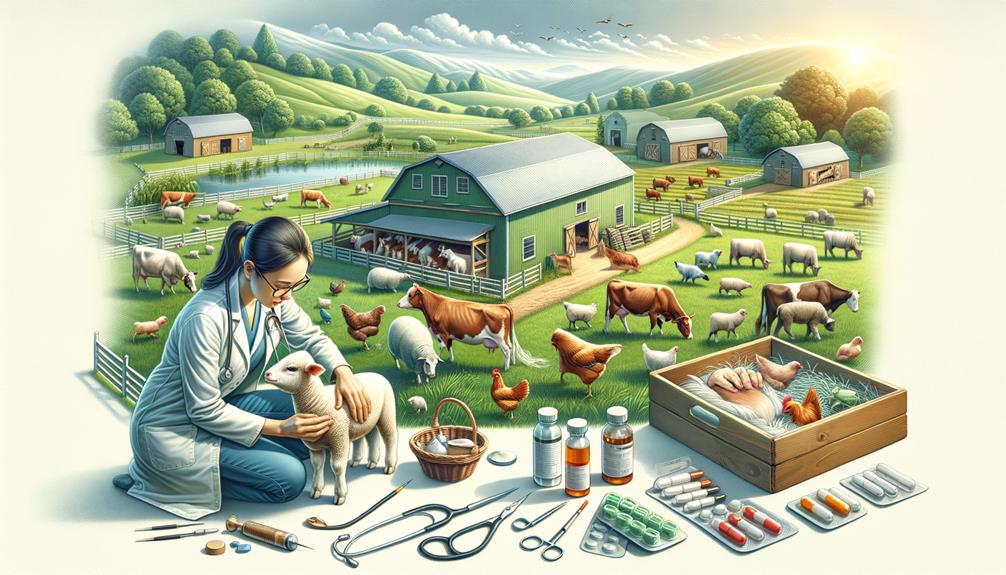When managing the breeding season, key factors like timing, habitat, nutrition, and health care are crucial. Birds rely on day length cues to trigger hormonal changes, so understanding timing is vital. A suitable habitat must provide space for nesting and rearing young, while a balanced diet rich in essential vitamins like A and D supports reproductive health. Regular veterinary checks and up-to-date vaccinations help prevent diseases. Observing mating behaviors offers insights into species-specific courtship strategies. Detailed record-keeping helps monitor reproductive trends and health, leading to better outcomes. By considering these interconnected elements, you can refine your breeding strategy and achieve success.
Key Takeaways
Breeding Season Considerations
When it comes to breeding season, birds rely on a combination of factors, including food availability, weather conditions, and day length cues, to time their breeding.
Proper nutrition plays a vital role in reproductive health, with vitamins A, D, and B-complex being particularly crucial.
To ensure birds have the space they need, habitat management is essential, including the creation of protected areas for territories and nests.
Regular veterinary check-ups and disease prevention measures are critical for maintaining high pregnancy rates.
Accurate and detailed breeding records are vital for tracking mating dates, parentage, and reproductive performance trends, allowing for informed decisions to be made.
Timing and Environmental Factors
Timing and environmental factors play a crucial role in determining the breeding success of bird species. Birds adapt to variations in food availability, weather conditions, and day length cues to ensure reproductive health and ideal body condition scoring, which directly impacts their ability to breed successfully.
For Arctic-breeding species, precise timing is vital. They must arrive at breeding grounds early, with sufficient fat reserves, to take advantage of the brief window of favorable conditions. Similarly, the Clay-colored Robin in Panama times its breeding season to coincide with the dry season, reducing predation risks and enhancing the chances of offspring survival.
Day length is a significant cue, triggering hormonal changes that signal the onset of breeding activities. This synchronization with environmental factors like insect emergence ensures that birds have the resources needed for rearing chicks. Research has shown that birds exhibit varied responses to external cues and possess innate biological clocks to regulate breeding timing.
Understanding these factors is vital for studying avian reproductive strategies and promoting the conservation of diverse bird species.
Habitat and Space Requirements

Understanding the specific habitat and space requirements of bird species is crucial for their successful breeding and long-term survival. I need to consider the precise habitat requirements of each species to achieve the best reproductive outcomes. Some birds thrive in dense forests, while others prefer open grasslands. Each habitat offers unique resources and conditions that influence breeding success.
Effective management of these habitats is vital. Birds require sufficient space to establish territories, build nests, and raise their young without excessive competition or predation. When space requirements are met, birds can access adequate food and shelter, which directly impacts reproductive success. For example, a species that nests in wetlands needs an environment that provides ample cover and food sources like insects and fish.
Human activities, such as deforestation and urbanization, greatly alter these habitats, posing threats to bird populations. By understanding and addressing these habitat requirements, I can implement conservation strategies that mitigate these threats. This includes creating protected areas, restoring natural habitats, and regulating land use to ensure that birds have the space they need to breed successfully. In doing so, I contribute to the preservation of avian biodiversity and the freedom of birds to thrive in their natural environments.
Nutritional Needs

When it comes to breeding animals, nutrition plays a critical role in reproductive health. A well-balanced diet that meets their increased energy demands during the breeding season is vital. Ensuring they receive the necessary nutrients can significantly improve breeding outcomes and overall health. By making informed diet adjustments, breeders can support the well-being of both males and females.
Essential Vitamin Supplements
Providing essential vitamin supplements is vital for maintaining the reproductive health of breeding animals. Deficiencies in vitamins like A, D, E, and B-complex can severely impair fertility and overall well-being. To optimize breeding success, meeting the nutritional needs of breeding animals through targeted vitamin supplementation is crucial.
Vitamin A, for instance, plays a key role in embryonic development. Vitamin D, on the other hand, ensures proper calcium metabolism, which is critical for bone health and egg production. Vitamin E acts as a powerful antioxidant, protecting reproductive tissues from oxidative damage and enhancing fertility. The B-complex vitamins support energy metabolism and ensure proper nerve function, both of which are crucial during high-stress breeding periods.
It's essential to understand the specific nutritional needs of each animal. Consulting with a veterinarian or nutritionist allows for tailored supplementation plans that address individual requirements, ensuring no deficiencies affect breeding performance. Effective vitamin supplementation not only boosts reproductive health but also secures the well-being of offspring, paving the way for a successful breeding season.
Balanced Diet Adjustments
To complement the benefits of targeted vitamin supplementation, adjusting the diet of breeding animals to meet their increased energy and nutrient requirements is crucial. A meticulous approach to their nutrition can significantly influence key reproductive metrics such as ovulation and conception rates. Ensuring that breeding stock maintains an ideal body condition score (BCS) of 3 to 3.5 prior to breeding is vital, as this supports the health of reproductive organs and overall breeding outcomes.
Diet adjustments should include essential vitamins, minerals, and proteins, which are vital for reproductive health. High-energy feeds, such as corn, combined with quality forage, can improve the reproductive performance of breeding animals. Consider the following dietary adjustments:
Increase energy intake to meet the elevated energy demands.
Adequate protein is necessary for muscle and tissue health, which is essential for reproduction.
Mineral balance is critical, with minerals like calcium and phosphorus playing key roles in reproductive processes.
Provide quality forage to ensure a steady supply of necessary nutrients.
Regularly monitor BCS to make timely dietary changes.
Health and Veterinary Care

Ensuring the health and veterinary care of breeding stock is crucial for successful mating outcomes and the overall well-being of the animals. Regular veterinary check-ups are vital to monitor the body condition score, which indicates an animal's readiness for breeding. Proper management practices are key to maintaining high pregnancy rates. By identifying and addressing underlying health issues early, we can significantly improve reproductive performance during the breeding season.
Up-to-date vaccinations are also essential, as they prevent the spread of diseases and safeguard the health of our breeding animals. Consistent monitoring of reproductive health allows us to detect potential issues before they escalate, ensuring higher fertility and more successful breeding outcomes.
When health concerns arise during the breeding season, prompt veterinary assistance is vital. This not only maximizes breeding success but also ensures the overall well-being of the animals. Through diligent attention to health and veterinary care, we can achieve our breeding goals while maintaining the highest standards of animal welfare. Effective management of our breeding stock relies on these practices, facilitating a successful and healthy breeding season.
Mating Behaviors

Understanding the intricacies of mating behaviors reveals the complex strategies animals employ to secure reproductive success. Male snakes, for example, engage in combat rituals to display strength and dominance, increasing their chances of winning mating opportunities. These interactions are crucial for establishing hierarchical structures and ensuring that only the fittest individuals reproduce.
Many species also exhibit elaborate courtship behaviors. Some snakes use intricate dances, tactile stimulation, or chemical signaling to attract mates. Birds, on the other hand, perform dramatic displays involving song, vivid plumage, or aerial acrobatics. These courtship behaviors serve not only to attract females but also to demonstrate the male's fitness and genetic quality.
During the breeding season, significant changes in hormone levels trigger increased aggression or territorial behaviors. These hormonal shifts are critical for males competing for mates, as they enhance their chances of reproductive success. Environmental cues and social structures also play vital roles, influencing mating rituals and shaping the dynamics within populations.
Combat rituals in male snakes, intricate dances and chemical signaling in snake courtship, elaborate bird displays involving song and plumage, hormonal changes influencing aggression and territoriality, and environmental and social factors affecting mating dynamics all contribute to the fascinating and varied world of animal mating behaviors.
Record-Keeping and Monitoring
When I keep detailed breeding records, I can accurately track mating dates, parentage, and reproductive performance, which is vital for making informed breeding decisions. By monitoring reproductive health indicators like estrus signs and fertility, I can quickly identify and address any issues, ensuring the best possible outcomes. Analyzing these records helps me identify patterns and trends that inform my breeding strategies and improve overall reproductive success.
Detailed Breeding Records
Maintaining detailed breeding records is crucial for optimizing breeding outcomes and tracking genetic trends. Through meticulous record-keeping, I can monitor reproductive performance and identify the most productive breeding pairs. Accurate breeding records provide valuable insights into mating dates, allowing me to predict and track estrus cycles with precision.
Keeping thorough records also enables me to document genetic information, which is vital for managing hereditary traits and preventing inherited disorders. By analyzing this data, I can make informed decisions to enhance the genetic diversity and overall health of my breeding stock.
Breeding records should include:
Mating dates to predict and confirm pregnancy.
Parentage information to track genetic traits and prevent inbreeding.
Reproductive performance to evaluate breeding effectiveness.
Genetic information to manage hereditary traits and conditions.
Estrus signs to improve breeding timing.
Health Status Tracking
By keeping a close eye on the health of my breeding stock, I can ensure their overall well-being and reproductive success. Tracking health status is a critical part of managing breeding animals, as it involves monitoring their body condition, detecting any signs of illness or injury, and documenting veterinary check-ups and treatments.
A detailed record-keeping system helps me gather essential information on estrus behavior, fertility rates, and breeding outcomes. This data enables me to identify potential health issues early on, addressing them promptly to prevent any negative impact on reproductive performance. For instance, monitoring body condition scores allows me to adjust nutrition and care strategies, promoting optimal health.
Continuous monitoring during the breeding season ensures that any reproductive issues are managed quickly. By documenting mating dates and health records, I can analyze trends and make informed decisions to improve the overall success of my breeding program. Accurate veterinary records, including vaccinations and treatments, are vital in maintaining the health of the breeding stock, leading to better reproductive outcomes.
Reproductive Performance Trends
Through meticulous record-keeping, I track reproductive performance trends to maximize the success of my breeding program. Detailed breeding records provide a thorough view of historical data, enabling me to identify patterns and make informed decisions. By monitoring reproductive health indicators, such as signs of estrus and fertility, I can predict the best breeding timing, increasing the chances of successful mating.
Accurate records are crucial for analyzing breeding performance patterns. By documenting mating dates, outcomes, and reproductive health indicators, I can identify potential issues affecting breeding success. This data-driven approach allows me to implement timely interventions and adjustments to enhance overall reproductive outcomes.
Breeding Records: Thorough logs of mating dates, outcomes, and health indicators.
Reproductive Health Indicators: Tracking signs of estrus, fertility, and other health metrics.
Breeding Timing: Predicting the optimal periods for mating to maximize success.
Historical Data Analysis: Identifying trends and patterns in reproductive performance.
Informed Decision-Making: Using data to improve breeding strategies and outcomes.
Maintaining detailed records empowers me to make strategic decisions based on reliable data, ensuring the continued success and improvement of my breeding program.
Frequently Asked Questions
What Determines a Breeding Season?
Certain environmental factors, like temperature and timing, dictate a breeding season. I find this fascinating because these elements directly impact snake survival strategies, ensuring species thrive through strategic synchronization and selective sperm storage.
What Happens in Breeding Season?
During breeding season, males often fight fiercely for dominance, while females choose their mates and store sperm for later use. The need for nutrients increases sharply, and environmental factors like food and weather have a major impact on reproductive behaviors and success.
What Factor Affects Cycling in Seasonal Breeders?
Imagine this scenario: the key to understanding cycling in seasonal breeders isn't about food or temperature, but rather daylight. As the days grow longer or shorter, hormonal changes occur, influencing reproductive cycles. This powerful environmental cue has a direct impact on their breeding behaviors.
Let me know if you want any further adjustments!
What Are the Seasons for Breeding Animals?
I find that the breeding seasons for animals vary depending on their species and habitat. In temperate regions, spring is usually the prime time, while in tropical areas, it coincides with the wet season. Environmental factors like food and daylight also play a significant role.



